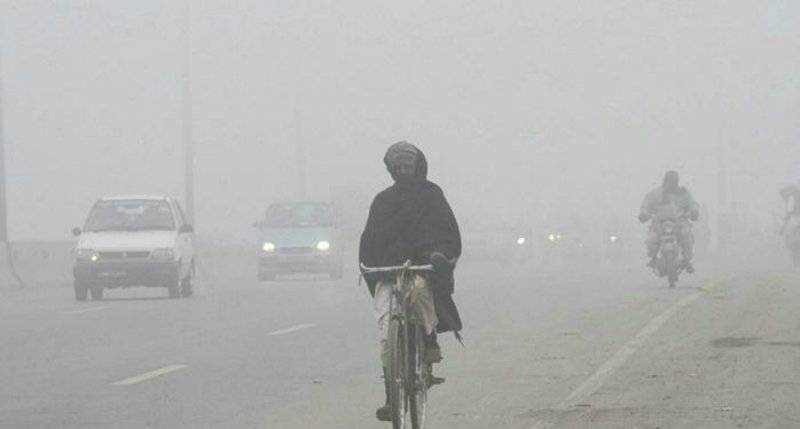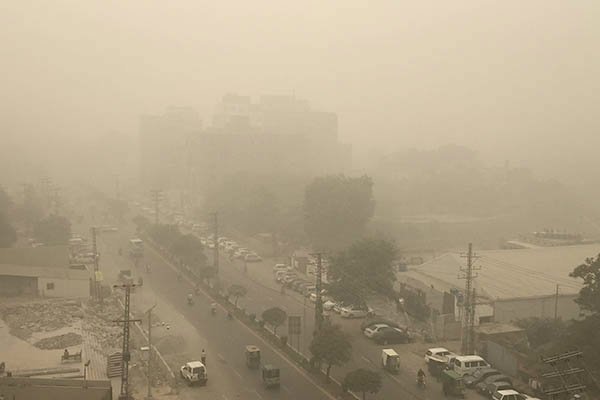Latest
Smog to stay for two months, says DG Met

“This situation is going to last till the end of December, as it hasn’t rained in the central Punjab since October,” said Dr Ghulam Rasool, Director General of the Pakistan Meteorological Department.
Read More: Smog not fog: Lahore encircled by noxious haze
Increase in air pollutants, the DG said, can be attributed to an uptick in motor vehicle pollution in the city, an accumulation of dust from ongoing construction projects, and changes in climate.
But it is the hot weather which has mainly contributed to the rise of smog in Punjab and other parts of the country, Dr Ghulam Rasool told Daily Pakistan on Wednesday.

Smog is a kind of air pollution, originally named for the mixture of smoke and fog in the air - a problem in a number of cities. Ground-level ozone, sulphur dioxide, nitrogen dioxide carbon monoxide are especially harmful to senior citizens, children, and people with heart and lung conditions such as emphysema, bronchitis, and asthma.
Read More: It’s official: India is sending its smog to Pakistan according to NASA
It can inflame breathing passages, decreasing the lungs' working capacity, and causing shortness of breath, pain when inhaling deeply, wheezing, and coughing.
When asked about a solution, the Met DG said the only natural way this smog could clear of is heavy rains or strong winds. “Even as light rain is expected in next 48 hours in upper parts of the country, including Gujranwala, Jhelum, Rawalpindi, Malakand and Hazara region, which would provide a temporary relief in the region. But it is unlikely to make any impact in lower parts including Lahore, Sahiwal and Faisalabad,” he added.
A recent report by Unicef says almost one in seven children worldwide live in areas with high levels of outdoor air pollution, mostly in South Asia, and their growing bodies are most vulnerable to damage.
The report, published by World Health Organization (WHO) last month, revealed that 92 percent of the world population lives in places where air quality levels exceed danger level, posing serious health hazards.
While the Unicef says as many as six million deaths in a year are caused by exposure to outdoor and indoor air pollution - more than malaria and HIV/AIDS combined. The most dangerous pollutant is particulate matter with a diameter of less than 2.5 micrometres, or PM 2.5.
Residents of Lahore are witnessing a dense blanket of smog that reduced visibility for commuters and prompted several complaints of respiratory problems and mental anguish.

Adding to the traffic woes, this haze can cause respiratory diseases if one is subjected to prolonged exposure to unsafe levels.
“It can cause eye and nose irritation and it dries out the protective membranes of the nose and throat and interferes with the body's ability to fight infection, increasing susceptibility to illness,” Dr Ghulam Rasool said.
In order to stay safe, people are advised to use face masks, take hot drinks, and avoid unnecessary outdoor trips.
Meanwhile, Dr Sajid Rashid, Principal Environment College, University of Punjab, has blamed paddy stubble burning in Pakistani and Indian Punjab as the main reason for rising level of smoke in the air.
Dr Rashid also referred to a high volume of firecrackers and fireworks on the festival of Diwali in India, which exacerbated the problem.
According to the U.S. Embassy in Delhi, the city’s Air Quality Index has reached hazardous levels.
“Unfortunately, in Pakistan, we lack the equipment for real-time monitoring of air quality,” he regretted while talking to DP Global. He added that an advisory warning to students has been issued and have been advised to take in water as much they could.
He further suggested people to avoid all outdoor physical activity when air quality is rated "severe" like this morning.
#smog #lahoreweather ?? pic.twitter.com/LFZNL9tvAh
— sarcasm won't leave. (@zainajawed) November 2, 2016
The author is working as Editor Digital Media for Daily Pakistan and can be reached @ItsSarfrazAli.


Advertisement
-
Honda CD 70 Dream latest price, installment plan in Pakistan April 2024
03:18 PM | 19 Apr, 2024 -
Canada plans to send migrants behind bars and here's how
02:59 PM | 19 Apr, 2024 -
Gold prices go up by Rs500 per tola in Pakistan
02:40 PM | 19 Apr, 2024 -
UK doubled visa issuance last year, data confirms
02:37 PM | 19 Apr, 2024 -
TikTok star Hareem Shah’s new video goes viral
02:30 PM | 19 Apr, 2024
Currency Rates in Pakistan Today - Pakistani rupee to US Dollar, Euro, Pound, Dirham, and Riyal - 19 April 2024
Pakistani currency saw minor adjustment against global currencies on April 19, 2024. US dollar was being quoted at 277.4 for buying and 280.4 for selling.
Euro comes down to 293 for buying and 296 for selling while British Pound stands at 342.25 for buying, and 345.65 for selling.
UAE Dirham AED was at 75.2 and Saudi Riyal's new rates was at 73.30.
Today’s currency exchange rates in Pakistan - 19 April 2024
| Currency | Symbol | Buying | Selling |
| US Dollar | USD | 277.4 | 280.4 |
| Euro | EUR | 293 | 296 |
| UK Pound Sterling | GBP | 342.25 | 345.65 |
| U.A.E Dirham | AED | 75.2 | 75.9 |
| Saudi Riyal | SAR | 73.3 | 74.05 |
| Australian Dollar | AUD | 181 | 182.8 |
| Bahrain Dinar | BHD | 740.09 | 748.09 |
| Canadian Dollar | CAD | 201 | 203 |
| China Yuan | CNY | 38.44 | 38.84 |
| Danish Krone | DKK | 39.69 | 40.09 |
| Hong Kong Dollar | HKD | 35.53 | 35.88 |
| Indian Rupee | INR | 3.33 | 3.44 |
| Japanese Yen | JPY | 1.86 | 1.94 |
| Kuwaiti Dinar | KWD | 902.64 | 911.64 |
| Malaysian Ringgit | MYR | 58.08 | 58.68 |
| New Zealand Dollar | NZD | 164.22 | 166.22 |
| Norwegians Krone | NOK | 25.31 | 25.61 |
| Omani Riyal | OMR | 722.87 | 730.87 |
| Qatari Riyal | QAR | 76.45 | 77.15 |
| Singapore Dollar | SGD | 204.5 | 206.5 |
| Swedish Korona | SEK | 25.31 | 25.61 |
| Swiss Franc | CHF | 305.08 | 307.58 |
| Thai Bhat | THB | 7.56 | 7.71 |
Advertisement
Lifestyle
Blogs
- Who is the most followed Pakistani actor on Instagram? 09:55 PM | 3 Apr, 2024
- Forbes 2024 List of World's Billionaires is out now: Taylor Swift, ChatGPT founder enter elite ranks 12:12 PM | 3 Apr, 2024
- Pakistan's ranking improves by 7 spots in Transparency International Corruption index 01:52 PM | 30 Jan, 2024
- Pakistan Army ranked among top 10 strongest militaries in the world 01:42 PM | 17 Jan, 2024
- 10 Top Google searches made by Pakistanis in 2024 09:36 PM | 20 Mar, 2024
- Famous People Who Passed Away in 2023 08:35 PM | 26 Dec, 2023
Follow us on Facebook
Follow us on Twitter
Sign up for Newsletter
Copyright ©2024. Reproduction of this website's content without express written permission from 'Daily Pakistan' is strictly prohibited.
